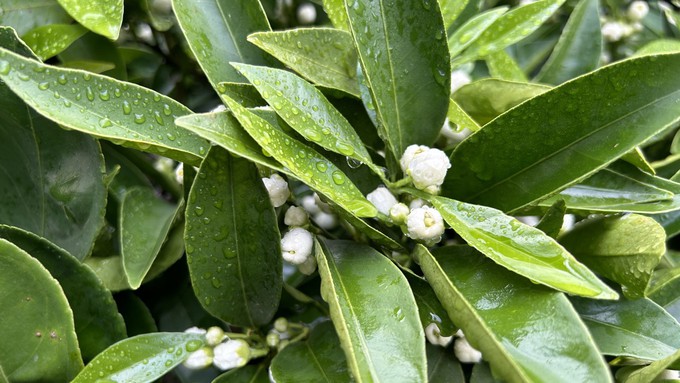
Spring gets off to rainy start, keeps temperatures cool

Rain is back but the totals this week won't be winter-like. There will be time to complete chores such as fertilizing citrus trees in bloom. Kathy Morrison
After a warm break with temperatures in the mid to upper 70s, our next week is going to feel more like winter than the beginning of spring.
According to the National Weather Service, hit-and-miss storm systems will keep us dodging rain drops through Friday. Cloud cover will dip afternoon temperatures into the low 60s, even the 50s – about 20 degrees colder than Thursday. Normal for mid-March in Sacramento: High of 65 and low of 44.
These showers will keep soil damp but not too wet. Sacramento’s rain total for the week is expected to be less than an inch.
In between cloud bursts, try to catch up with early spring chores. The weeds aren’t waiting! (At least, the soft soil makes them easier to pull.)
* Attack weeds now! Get them before they flower and go to seed. Take a hoe and whack them as soon as they sprout. Aim for 1 inch below the soil line.
* Start preparing vegetable beds. Spade in compost and other amendments.
* Prune and fertilize spring-flowering shrubs after bloom.
* Feed camellias at the end of their bloom cycle. Pick up browned and fallen flowers to help corral blossom blight.
* Feed citrus trees, which are now in bloom and setting fruit. To prevent sunburn and borer problems on young trees, paint the exposed portion of the trunk with diluted white latex (water-based) interior paint. Dilute the paint with an equal amount of cold water before application.
* Feed roses with a balanced fertilizer (such as 10-10-10, the ratio of nitrogen, phosphorus and potassium available in that product).
* Prune and fertilize spring-flowering shrubs and trees after they bloom. Try using well-composted manure, spread 1-inch thick under the tree. This serves as both fertilizer and mulch, retaining moisture while cutting down on weeds.
* Cut back and fertilize perennial herbs to encourage new growth.
* Seed and renovate the lawn (if you still have one). Feed cool-season grasses such as bent, blue, rye and fescue with a slow-release fertilizer. Check the irrigation system and perform maintenance. Make sure sprinkler heads are turned toward the lawn, not the sidewalk.
* In the vegetable garden, transplant lettuce and cole family plants, such as cabbage, broccoli, collards and kale.
* Seed chard and beets directly into the ground.
* Plant summer bulbs, including gladiolus, tuberous begonias and callas. Also plant dahlia tubers.
* Shop for perennials. Many varieties are available in local nurseries and at plant events. They can be transplanted now while the weather remains relatively cool.
Comments
0 comments have been posted.Sacramento Digs Gardening to your inbox.
Sites We Like
Garden Checklist for week of May 5
Survey your garden after the May 4 rainstorm. Heavy rain and gusty winds can break the neck of large flowers such as roses. Also:
* Keep an eye on new transplants or seedlings; they could take a pounding from the rain.
* Watch out for powdery mildew. Warmth following moist conditions can cause this fungal disease to “bloom,” too. If you see a leaf that looks like it’s dusted with powdered sugar, snip it off.
* After the storm, start setting out tomato transplants, but wait on the peppers and eggplants (they want warmer nights). Pinch off any flowers on new transplants to make them concentrate on establishing roots instead of setting premature fruit.
* Trim dead flowers but not leaves from spring-flowering bulbs such as daffodils and tulips. Those leaves gather energy to create next year's flowers. Also, give the bulbs a fertilizer boost after bloom.
* Pinch chrysanthemums back to 12 inches for fall flowers. Cut old stems to the ground.
* Mulch around plants to conserve moisture and control weeds.
* From seed, plant beans, beets, cantaloupes, carrots, corn, cucumbers, melons, pumpkins, radishes and squash.
* Plant onion sets.
* In the flower garden, plant seeds for asters, cosmos, celosia, marigolds, salvia, sunflowers and zinnias. Transplant petunias, zinnias, geraniums and other summer bloomers.
* Plant perennials and dahlia tubers for summer bloom.
* Don’t wait; plant summer bulbs, such as gladiolus and tuberous begonias.
* Harvest cabbage, lettuce, peas and green onions.